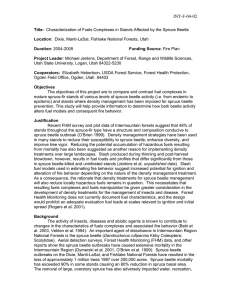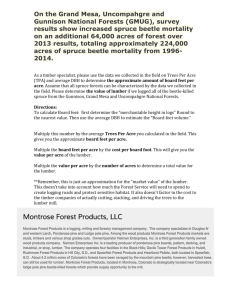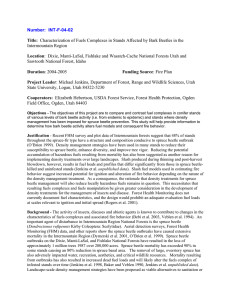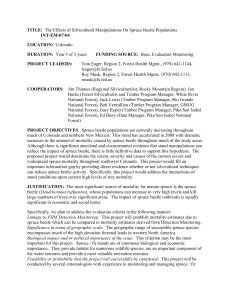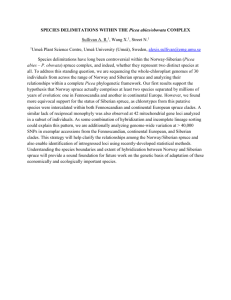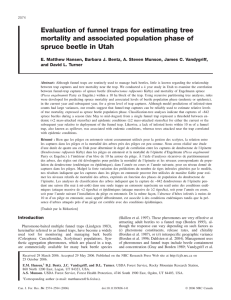Document 11089812
advertisement
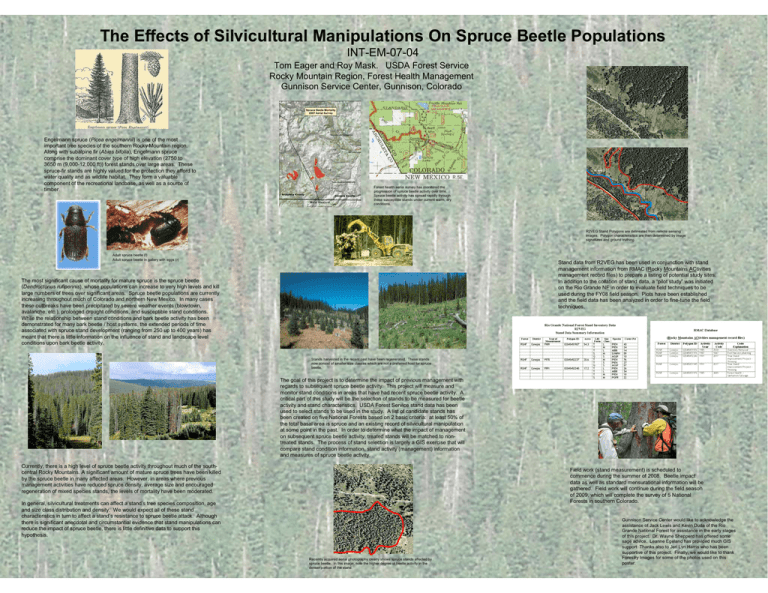
The Effects of Silvicultural Manipulations On Spruce Beetle Populations INT-EM-07-04 Tom Eager and Roy Mask. USDA Forest Service Rocky Mountain Region, Forest Health Management Gunnison Service Center, Gunnison, Colorado Engelmann spruce (Picea engelmannii) is one of the most important tree species of the southern Rocky Mountain region. Along with subalpine fir (Abies bifolia), Engelmann spruce comprise the dominant cover type of high elevation (2750 to 3650 m (9,000-12,000 ft)) forest stands over large areas. These spruce-fir stands are highly valued for the protection they afford to water quality and as wildlife habitat. They form a valuable component of the recreational landbase, as well as a source of timber. Forest health aerial survey has monitored the progression of spruce beetle activity over time. Spruce beetle activity has spread rapidly through these susceptible stands under current warm, dry conditions. R2VEG Stand Polygons are delineated from remote sensing images. Polygon characterisitics are then determined by image signatures and ground truthing. Adult spruce beetle (l) Adult spruce beetle in gallery with eggs (r) Stand data from R2VEG has been used in conjunction with stand management information from RMAC (Rocky Mountains ACtivities management record files) to prepare a listing of potential study sites. In addition to the collation of stand data, a “pilot study” was initiated on the Rio Grande NF in order to evaluate field techniques to be used during the FY08 field season. Plots have been established and the field data has been analyzed in order to fine-tune the field techniques. The most significant cause of mortality for mature spruce is the spruce beetle (Dendroctonus rufipennis), whose populations can increase to very high levels and kill large numbers of trees over significant areas. Spruce beetle populations are currently increasing throughout much of Colorado and northern New Mexico. In many cases these outbreaks have been precipitated by severe weather events (blowdown, avalanche, etc.), prolonged drought conditions, and susceptible stand conditions. While the relationship between stand conditions and bark beetle activity has been demonstrated for many bark beetle / host systems, the extended periods of time associated with spruce stand development (ranging from 250 up to 400 years) has meant that there is little information on the influence of stand and landscape level conditions upon bark beetle activity. Stands harvested in the recent past have been regenerated. These stands now consist of smaller size classes which are not a preferred host for spruce beetle. The goal of this project is to determine the impact of previous management with regards to subsequent spruce beetle activity. This project will measure and monitor stand conditions in areas that have had recent spruce beetle activity. A critical part of this study will be the selection of stands to be measured for beetle activity and stand characteristics. USDA Forest Service stand data has been used to select stands to be used in the study. A list of candidate stands has been created on five National Forests based on 2 basic criteria: at least 50% of the total basal area is spruce and an existing record of silvicultural manipulation at some point in the past. In order to determine what the impact of management on subsequent spruce beetle activity, treated stands will be matched to nontreated stands. The process of stand selection is largely a GIS exercise that will compare stand condition information, stand activity (management) information and measures of spruce beetle activity. Currently, there is a high level of spruce beetle activity throughout much of the southcentral Rocky Mountains. A significant amount of mature spruce trees have been killed by the spruce beetle in many affected areas. However, in areas where previous management activities have reduced spruce density, average size and encouraged regeneration of mixed species stands, the levels of mortality have been moderated. Field work (stand measurement) is scheduled to commence during the summer of 2008. Beetle impact data as well as standard mensurational information will be gathered. Field work will continue during the field season of 2009, which will complete the survey of 5 National Forests in southern Colorado. In general, silvicultural treatments can affect a stand’s tree species composition, age and size class distribution and density. We would expect all of these stand characteristics in turn to affect a stand’s resistance to spruce beetle attack. Although there is significant anecdotal and circumstantial evidence that stand manipulations can reduce the impact of spruce beetle, there is little definitive data to support this hypothesis. Recently acquired aerial photography clearly shows spruce stands affected by spruce beetle. In this image, note the higher degree of beetle activity in the denser portion of the stand. Gunnison Service Center would like to acknowledge the assistance of Jack Lewis and Kevin Duda of the Rio Grande National Forest for assistance in the early stages of this project. Dr. Wayne Shepperd has offered some sage advice. Leanne Egeland has provided much GIS support Thanks also to Jeri Lyn Harris who has been supportive of this project. Finally, we would like to thank Forestry Images for some of the photos used on this poster.




